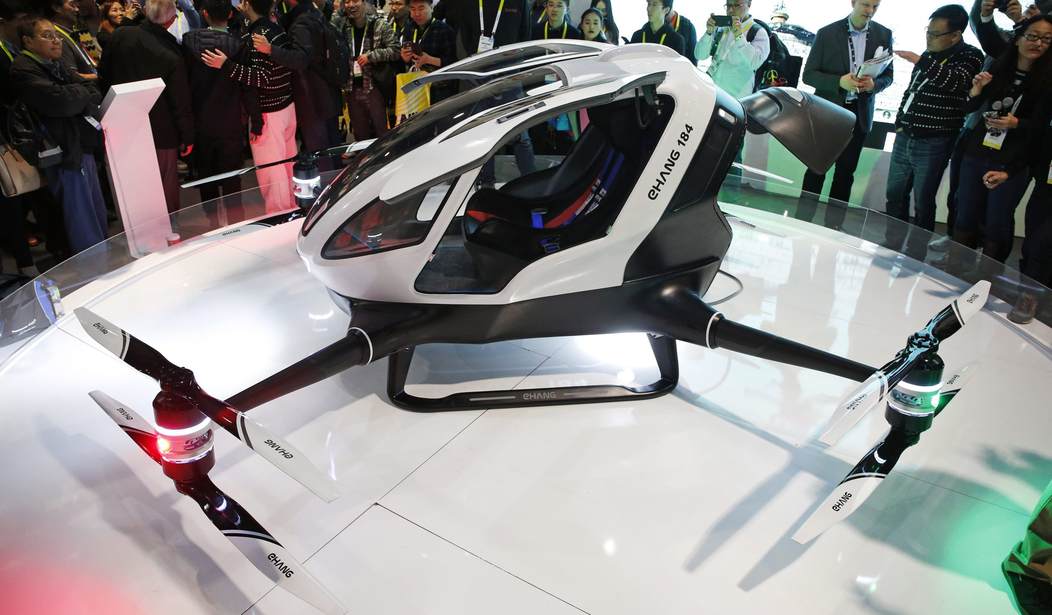Nevada’s economic development team wants their state to be a “global leader” in drones. More specifically, Nevada seeks to lead the world in the development of unmanned aerial vehicles — drones that fly themselves and carry passengers.
In March 2016, the first urban drone delivery — a package containing bottled water, emergency food, and a first-aid kit — was conducted in Hawthorne, Nev., which isn’t exactly a bustling metropolis.
But Matthew Sweeney, the CEO of Flirtey, the company that did the test flight, said it’s a start. He told Popular Science the next goal is to do a drone delivery “over an urban, populated area, the kind of environment that people live in on a daily basis.”
A couple of months later, Nevada became the first state in the nation, in May 2016, where a fixed-wing unmanned aircraft successfully tested a cloud-seeding payload.
“This is a tremendous accomplishment for the state of Nevada, and everyone involved,” the project’s lead scientist, Adam Watts, told the Las Vegas Review-Journal.
And now comes the EHang 184, a passenger-drone taxi that will be tested in Nevada by EHang Inc, a company based in China.
The Nevada Governor’s Office of Economic Development and the public-private partnership known as the Nevada Institute for Autonomous Systems have agreed to collaborate with EHang on flight testing, training and development of the drone taxi at Nevada’s FAA UAS (Unmanned Aerial Systems) Test Site.
Tom Wilczek, the GOED’s Aerospace and Defense Industry Specialist, said in a statement that he looked “forward to the day when drone taxis are part of Nevada’s transportation system.”
Huazhi Hu, the founder and CEO of EHang, said the partnership with Nevada would lay the foundation for the commercialization of the EHang 184.
EHang has already signed a deal with Lung Biotechnology to use the 184 for organ transportation. Helicopters and land vehicles are now routinely used to transport human organs.
But Lung Biotechnology and EHang want to put 1,000 EHang 184s into the air over the next 15 years, thereby creating what they envision as the Manufactured Organ Transport Helicopter system.
But first things first: Wilczek said their primary goal was to “achieve a safe flight” and convince the Federal Aviation Administration the EHang 184 is not only safe but reliable.
It’s understandable a government bureaucracy might be worried about putting people into the air in drones.
The EHang 184 has a four-rotor design that most of us are accustomed to seeing on a drone. It is an electric vehicle that can carry one passenger and a small piece of luggage — 220 pounds total.
With that on board, EHang says the 184 should be able to fly for 23 minutes at sea level — 1,000 feet to 1,650 feet off the ground, or up to 63 miles an hour for 10 minutes at a higher altitude — up to 11,500 feet high.
The cabin is air conditioned with a reading light, and here’s a cool feature — the propellers fold up after landing so the UAV can fit into a single parking-lot space.
This is an autonomous vehicle. Just enter a desired landing location on the EHang app on a Microsoft Surface tablet, and the EHang 184 takes you where you want to go. The only instructions needed are “take off” and “land,” and the EHang 184 does the rest.
Of course, something could go wrong. It is mechanical, after all. But not to worry, EHang assures the FAA, and its passengers, that even if three of the four rotors break down, the EHang 184 can fly with only one rotor.
But this might concern the average passenger or government bureaucrat. If that last rotor goes out, or while the first three blades stop spinning, there is absolutely nothing the passenger can do except keep his or her hands or feet inside the ride.
EHang said if the worst case does happen, its control center will take over flying the craft. Again, there is nothing the passenger has to do — or can do.
However, EHang said that when the 184 was introduced in January 2016 at the Consumer Electronics Show in Las Vegas the drone had flown more than 100 times at low altitude, and with a passenger on several of the flights. Nobody has been hurt.
Passenger fares would probably have to be rather expensive. The EHang 184 will be priced at $200,000 to $300,000.
The FAA has selected sites in Nevada, Alaska, New York, North Dakota, Texas and Virginia as locations for the testing and development of unmanned aerial vehicles (UAVs) like the EHang 184.
Nevada is pitching this new industry hard, touting its wide-open spaces that are close to more than half-a-dozen international airports and Air Force bases that are perfect to build and test UAVs.
And, why would Nevada go hard after this? Even though the idea of flying drone taxis buzzing people wherever they want to go might seem farfetched and the stuff of science fiction, the Governor’s Office of Economic Development forecasts the UAV industry could pump as much as $8 billion into the state’s economy.
Rama Venkat, the interim dean of UNLV’s Howard R. Hughes College of Engineering, which is offering research assistance and facilities to the UAV industry, maintained there’s a lot to be said for being on the cutting edge.
“I am confident that Nevada’s economy will see a paradigm shift within the next decade due to the explosion of UAV-based technologies,” Venkat said.









Join the conversation as a VIP Member